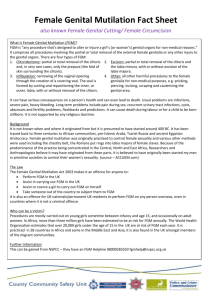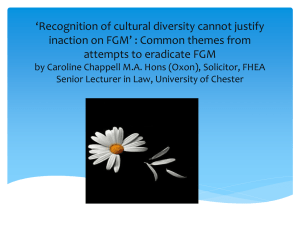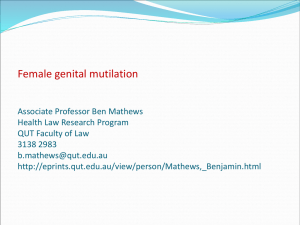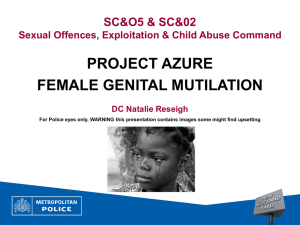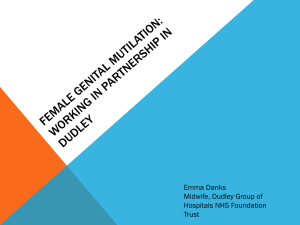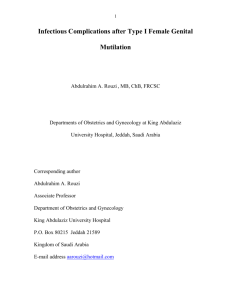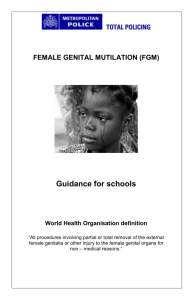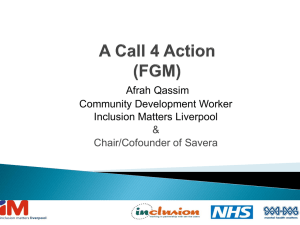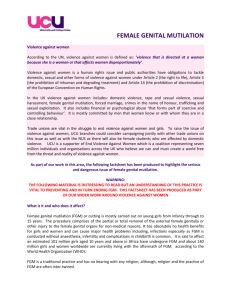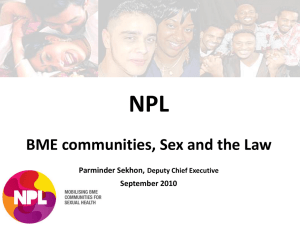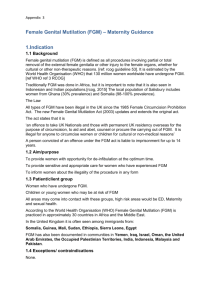NoFGM Oz Handout - FELICITY GERRY QC
advertisement
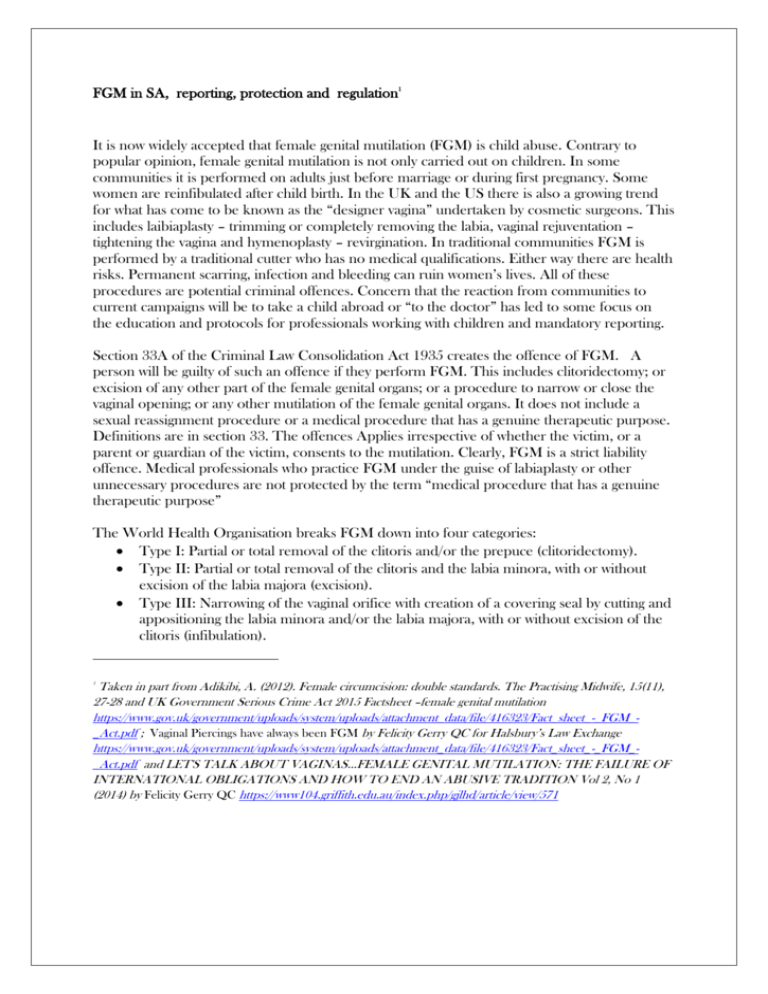
FGM in SA, reporting, protection and regulation1 It is now widely accepted that female genital mutilation (FGM) is child abuse. Contrary to popular opinion, female genital mutilation is not only carried out on children. In some communities it is performed on adults just before marriage or during first pregnancy. Some women are reinfibulated after child birth. In the UK and the US there is also a growing trend for what has come to be known as the “designer vagina” undertaken by cosmetic surgeons. This includes laibiaplasty – trimming or completely removing the labia, vaginal rejuventation – tightening the vagina and hymenoplasty – revirgination. In traditional communities FGM is performed by a traditional cutter who has no medical qualifications. Either way there are health risks. Permanent scarring, infection and bleeding can ruin women’s lives. All of these procedures are potential criminal offences. Concern that the reaction from communities to current campaigns will be to take a child abroad or “to the doctor” has led to some focus on the education and protocols for professionals working with children and mandatory reporting. Section 33A of the Criminal Law Consolidation Act 1935 creates the offence of FGM. A person will be guilty of such an offence if they perform FGM. This includes clitoridectomy; or excision of any other part of the female genital organs; or a procedure to narrow or close the vaginal opening; or any other mutilation of the female genital organs. It does not include a sexual reassignment procedure or a medical procedure that has a genuine therapeutic purpose. Definitions are in section 33. The offences Applies irrespective of whether the victim, or a parent or guardian of the victim, consents to the mutilation. Clearly, FGM is a strict liability offence. Medical professionals who practice FGM under the guise of labiaplasty or other unnecessary procedures are not protected by the term “medical procedure that has a genuine therapeutic purpose” The World Health Organisation breaks FGM down into four categories: Type I: Partial or total removal of the clitoris and/or the prepuce (clitoridectomy). Type II: Partial or total removal of the clitoris and the labia minora, with or without excision of the labia majora (excision). Type III: Narrowing of the vaginal orifice with creation of a covering seal by cutting and appositioning the labia minora and/or the labia majora, with or without excision of the clitoris (infibulation). Taken in part from Adikibi, A. (2012). Female circumcision: double standards. The Practising Midwife, 15(11), 27-28 and UK Government Serious Crime Act 2015 Factsheet –female genital mutilation https://www.gov.uk/government/uploads/system/uploads/attachment_data/file/416323/Fact_sheet_-_FGM__Act.pdf ; Vaginal Piercings have always been FGM by Felicity Gerry QC for Halsbury’s Law Exchange https://www.gov.uk/government/uploads/system/uploads/attachment_data/file/416323/Fact_sheet_-_FGM__Act.pdf and LET'S TALK ABOUT VAGINAS...FEMALE GENITAL MUTILATION: THE FAILURE OF INTERNATIONAL OBLIGATIONS AND HOW TO END AN ABUSIVE TRADITION Vol 2, No 1 (2014) by Felicity Gerry QC https://www104.griffith.edu.au/index.php/gjlhd/article/view/571 1 Type IV: All other harmful procedures to the female genitalia for non-medical purposes, for example: pricking, piercing, incising, scraping and cauterization. Note that, as explained in the 2008 Guidance, pricking, piercing and incision are defined as procedures in which the skin is pierce with a sharp object, following which blood may be left but no tissue is removed. Cauterization is defined as the destruction of tissue by burning it with a hot iron. Whilst the WHO categories of FGM are not exactly duplicated in the 1935 Act, they do help to define the words “other mutilation” in the statutory definition. They also reflect the various ways in which FGM is carried out in different traditional communities. The time for cultural relativism has gone. The question is how to combat FGM amongst migrant communities from countries that maintain traditional practices and how to regulate vaginal cosmetic surgery. The criminal legislation is not altogether comprehensive. In relation to children, it is important to understand that FGM is often carried out against children who are from otherwise loving families. The legislation envisages the performing of FGM. Accessorial liability is left to general principles of criminal law rather than specifically provided for. Extra territorial offences are provided for by s33B so that extra territorial jurisdiction extends to a child removed from the State for genital mutilation. This prohibits a person from taking a child from the State or arranging for a child to be taken from the State, with the intention of having the child subjected to FGM. Intention is presumed and can therefore be rebutted. There has still been no successful prosecution for FGM in SA. The real target is the back street cutters and the community pressure on parents. However, there is no offence of failing to protect a girl from FGM so proof is still required of performance, conspiracy or accessorial liability which is often difficult to obtain. SA courts can make an FGM protection order pursuant to section 26B of the Children’s Protection Act 1993 to prevent a person from taking a child from the State, holding a passport and periodic examination of the child to ensure the child is not subjected to FGM. In relation to mandatory reporting, Part 4 of the Children’s Protection Act 1993 creates an obligation on certain people to notify Families SA via the Child Abuse Report Line (CARL) if they suspect on reasonable grounds that a child/ young person has been, or is being, abused and/or neglected and the suspicion is formed in the course of the person’s work (whether paid or voluntary) or in carrying out official duties. Abuse or neglect, in relation to a child, is defined to include “physical or emotional abuse of the child, or neglect of the child, to the extent that the child has suffered, or is likely to suffer, physical or psychological injury detrimental to the child's wellbeing; or the child's physical or psychological development is in jeopardy, The physical and psychological injury from FGM is well documented so regulated persons should be reporting suspicions in relation to FGM.
